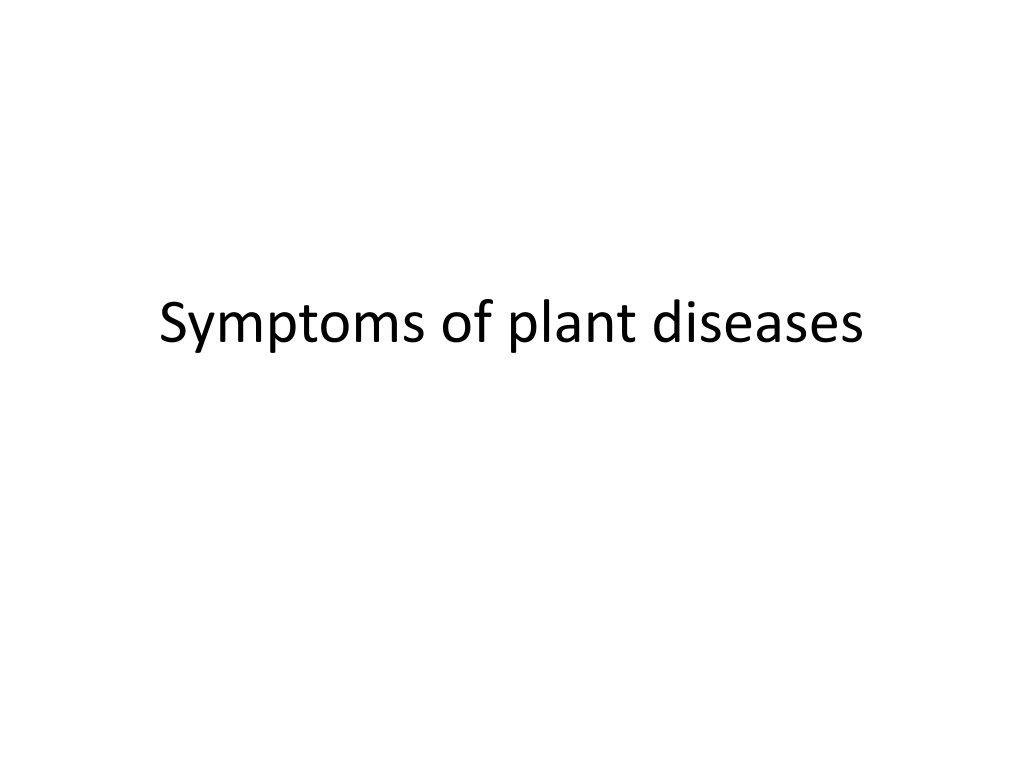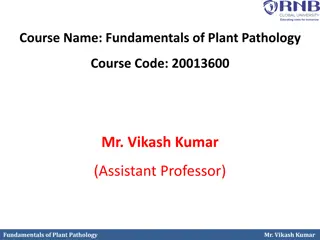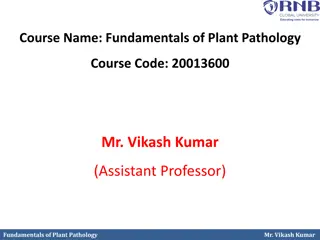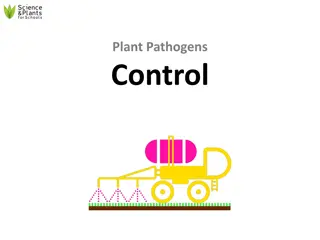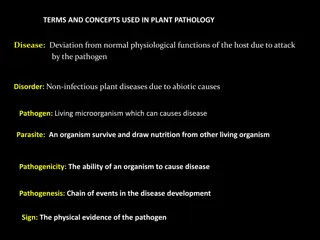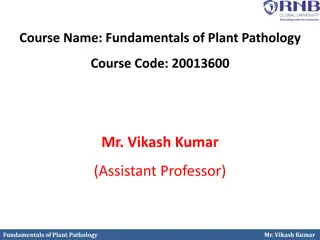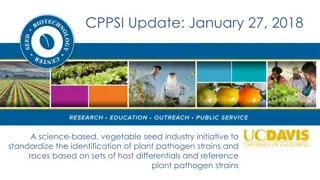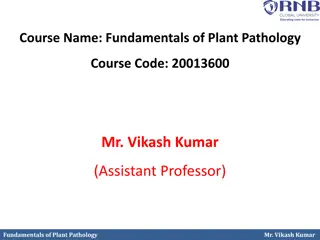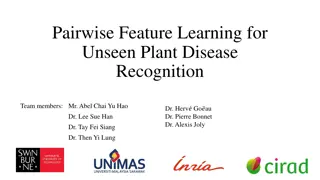Understanding Plant Diseases: Symptoms and Identification
Plant diseases induce reactions in host plants, leading to visible abnormalities known as symptoms. Common symptoms include mildew, rusts, smuts, white blisters, and blotches. Each type of disease manifests differently, such as powdery growth in mildew and pustules in rusts. Proper identification of these symptoms is crucial for effective disease management in plants.
Download Presentation

Please find below an Image/Link to download the presentation.
The content on the website is provided AS IS for your information and personal use only. It may not be sold, licensed, or shared on other websites without obtaining consent from the author. Download presentation by click this link. If you encounter any issues during the download, it is possible that the publisher has removed the file from their server.
E N D
Presentation Transcript
Plant pathogens induce reactions in the body of their host. As a result certain abnormalities appear on the plant. In addition the pathogen may itself become visible on the host surface .
The abnormalities , sign or the evidence of the disorder are known as symptoms of the. disease
Mildew: Pathogen is seen as white, grey ,brownish or purplish growth on the host surface. In downy mildews the superficial growth is a tangled cottony or downy growth while in powdery mildews enormous numbers of spores are formed on superficial growth of the fungus giving the host surface a dusty or powdery appearance.
Black minute fruiting bodies may also develop in the powdery mass
Rusts: Diseases with rusty symptoms They appear as relatively small pustules of spores usually breaking through the host epidermis. Pustule maybe either dusty or compact . Red,brown,yellow or black in colour.
Smuts: Word means a sooty or charcoal like powder. Affected plants show a black or purplish black dusty mass It maybe found on stem, leaves as well as roots
White blisters: on leaves of cruciferous there maybe found numerous white blister like pustules which break open the epidermis and expose powdery masses of spores. and other plants
Blotch: This symptom consists of a superfluous growth giving the fruit a blotched appearance as in the sooty blotch and flyspeck of apple fruits
Sclerotia: A sclerotium is a compact , often hard mass of dormant fungus mycelium. In some diseases as in ergot of graminaceous plants the sclerotium assumes a characteristic shape . In others it maybe variable
Exudations: In several bacterial diseases such as in bacterial blight of paddy, bacterial leaf streak of paddy and fire blight of pome fruits masses of bacterial cells ooze out to the surface of the affected organ where they maybe seen as drops or smear.
Symptoms resulting from internal disorders in the host plant may appear in one or more of the following forms: Colour change: change of colour from the noremal or discolouration is one of the most common symptoms of plant diseases. The green pigment may disappear entirely and its place maybe taken by yellow pigments.
When this yellowing is due to lack of light it is called etiolation.
A similar condition results from the influence of low temperature, lack of iron, excess of lime r alkali in the soil and infection by viruses , fungi and bacteria In these cases the yellowing is known as chlorosis .
sometimes the leaves are devoid of any pigment and look bleached or white. This condition is known as albinism Change of colour to red, purple or orange is chromosis
Overgrowths and hypertrophy: Many pathogens through their biochemical activity induce excessive growth of host tissues. This causes abnormal increase in size of affected organs
It is brought about by one or both of the two processes known hypertrophy. Hyperplasia is the abnormal increase in the size of a plant organ due to increase in number of cells of which the organ is composed. as hyperplasia and
The cell division is increased and so the number of cells at a given location is much higher than normal In hypertrophy the increased size of the organ is due to increase in the size of cells of a particular tissue.
The pathogen may dissolve intervening walls between adjacent cells or biochemicals RELEASED by it may cause the cell to increase in size. The overgrowths and their effects are of different types such as galls, curl, pocket or bladder, hairy root , witches broom, intumescence etc
Atrophy: Or hypoplasia or Dwarfing: In many diseases one of the results is inhibition of growth resulting in stunting or dwarfing
The whole plant maybe dwarfed or only certain organs maybe affected Sometimes hypertrophy and atrophy both are present in the same organ
Necrosis: Indicates the condition in which death of cells , tissues and organs has occurred as a result of parasitic activity. Symptoms: spots, streaks, stripes, canker, blight, damping off, burn, scald or scorch and rot
Wilts: Drying of the entire plant Loose turgidity Become flaccid and droop
Die back or wither tip: Drying of plant organs especially stem or branches
Defence mechanism Physiological or biochemical defence is more important and common defence as methods for resisting invasion by plant pathogens than structural
By biochemical conditions and reactions the host inactivates the pathogen or its toxins or kills it before the infection spreads and the disease becomes serious
These biochemical mechanisms maybe present in the plant prior to attack. But more commonly they develop in response to pathogenic activities(post infectional biochemical defence)
The chemical compounds present in the plant or synthesised in response to infection have been classified. The antifungal components can be classified into four groups: (according to Ingham)
1. Prohibitins 2. Inhibitins 3. Post inhibitins 4. Phytoalexins
Proinhibitins constituents constitutive or semi constitutive defence materials. and of inhibitins the are involved normal plant in
Post inhibitins are formed by minor alterations of pre existing compounds. Phytoalexins are post infectionally produced metabolites.
Bell had called the compounds pre existing in the plant as constitutive antibiotics Those formed in response to wounds as wound antibiotics
1. Antifungal and antimicrobial compounds released by the plant in the environment: during the growth activities of higher continuous exchange of materials with the surrounding environment. and plants accompanying there is a
Plants not only take in water and nutrients from soil and carbon di oxide and oxygen from the atmosphere but also liberate gases as well as organic substances from leaves and roots.
These leaf and root exudates contain those biochemicals which are produced during metabolic processes of the plant cells such as amino acids, sugars, glycosides, organic acids, enzymes, alkaloids, flavanones, inorganic acids, and also certain growth factors and toxic materials nucleotides and
They have a profound effect on the nature of the environment including the phyllosphere and the rhizosphere microflora and fauna. These substances may accumulate in minute drops on leaf surfaces or diffuse in the moisture of the environment around leaves and roots.
A number of inhibitory substances are also included in the exudates. They directly affect microorganisms or encourage certain groups to dominate the environment and function as antagonists of the pathogen
Tomato leaves- excrete chemicals that provide resistance to attack of Botrytis cinerea. Cowpea leaves resistant to Cercospora leaf spot -toxic substances that inhibit germination of conidia.
In leaf spot of sugarbeet ( Cercospora beticola) low incidence of local lesions on the leaves of a resistant variety has been corelated with the presence of a diffusible inhibitor from healthy leaves
Spore germination of the fungus inhibited by resistant leaves, their water washings and dew deposited on such leaves.
Certain powdery mildew resistant varieties of apple exude toxic waxes on leaf surfaces which prevent germination of conidia of Podosphaera leucotricha Apple varieties producing low amounts of this wax are usually susceptible to powdery mildews.
Epidermal excretions play an important role in establishing infection of Plasmopara viticola. Red scales of onion contain protocatechuic acid and catechol which may exude in drops and impart resistance Colletotrichum circinans to attack of
These germination of the fungus Wrinkled seeded susceptible to seed and root rot because the seeds exude very high quantities of sugars which encourage the growth of pythium phenolic substances inhibit spore varieties of pea are
Indirectly the exudates may suppress the growth of pathogens by encouraging other microorganisms to grow and compete with the pathogen or produce antibiotics
Root exudates sometimes contain substances that are directly toxic to a pathogen Certain varieties of linseed resist wilt caused by F oxysporum f. sp. Lini through the presence of hydrocyanides in their root exudates. Extremely toxic to the wilt pathogen Reduces its infectivity around the roots
It is present in the roots also and imparts resistance. Does not affect the development of trichoderma spp
Marigold used in biological control of nematodes Presence of polyenes, terthienyl and derivatives of biethienyl in the root and root exudates
Asparagus officinalis-toxic material against nematode trichodorus christiei Cucurbits(bitter cucumber)- cucurbitacin=nematode
